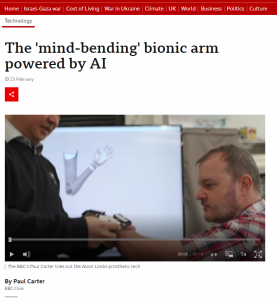
Over the last decade, 3D printing technology has improved drastically, with the main focus from commercial businesses being to reduce their complexity and improve their usability. In contrast, whilst the technology in the medical industry has also improved, complexity has also increased with it. As a Biomedical Electronic Engineer, I am particularly interested in the application of 3D printing within the medical industry.
________________________________________________________________________________________________________________
So, what are the main applications of 3D printing in the medical industry?
Bioprinting
Bioprinting has revolutionised organ transplantation by offering a unique, custom solution. Foreign body rejection can be mitigated using the patient’s own stem cells reducing the need of further surgery. It also eliminates the sometimes agonizing wait time for an organ match – in March 2023, there were around 7000 people waiting for a replacement in the UK alone, so this issue could be avoided entirely. However, the high cost, complexity and ethical implications pose significant challenges, making it inaccessible for some individuals.
Surgery

3D printing can also be used in surgery to make custom tools for different procedures, and to aid with surgical preparation. One of the most interesting moments for me on this module was visiting the IDS building at the hospital, and learning how scans were used to create a custom hip for a lady requiring a hip replacement. This device helped the surgeons to practice the procedure, whilst also providing the patient with a safe solution. A standard operation would have been difficult and risky due to the level of bone loss; this model helped to replace necrotic (dead) tissue and also bone which had been removed from prior surgeries. After studying modules which covered topics similar to this, it was interesting to see a physical example of a hip replacement, and I found it inspiring that someone could be helped using 3D printing.
Prosthetics
Custom prosthetics can be developed to improve millions of lives – something that motivates me to pursue a career in this field. 3D printers have a massive range of flexibility when it comes to manufacturing, so different designs can be made very easily without the need of additional hardware. I am currently designing a 3D printed prosthetic hand as part of my individual project using my own FDM 3D printer. FDM (Fused Deposition Modelling) is the simplest form of 3D printing; it relies on the layering of molten thermoplastics to produce a 3D object. This project alone has illustrated to me that modern 3D printers have an extremely wide variety of uses at a relatively low cost, with further technological advancements potentially increasing the accessibility of custom prosthetics across the world, helping millions more people in the process.

I personally think that this technology will develop further to the point where any physiological issue can be resolved using something that has been 3D printed – there has been a massive advancement in this field in the last 20 years, so who knows what its capabilities could be in another 20 years!
Overall, 3D printing has provided an efficient solution to complex problems within different industries – especially the medical industry. Different printing methods have contributed to improving countless lives which has inspired many people, including myself, to develop the technology further and hopefully help many more people in the process.




Very well written, with an excellent format and images. You’ve included interesting statistics and related it to personal ideas which…
This is a very well written blog, the format is as if you are talking directly to me. The ideas…
Love the Batman GIF :)
This is an excellent, well written blog. The narrative is engaging and easy to follow. It could be improved by…
This is a well-communicated blog. The it is written well with good use of multimedia. It could be improved with…